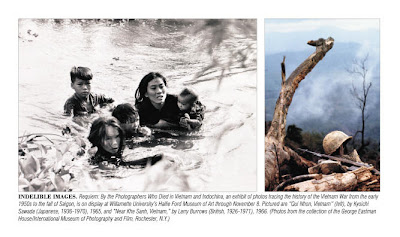 INDELIBLE IMAGES. Requiem: By the Photographers Who Died in Vietnam and Indochina, an exhibit of photos tracing the history of the Vietnam War from the early 1950s to the fall of Saigon, is on display at Willamette University’s Hallie Ford Museum of Art through November 8. Pictured are "Qui Nhon, Vietnam" (left), by Kyoichi Sawada (Japanese, 1936-1970), 1965, and "Near Khe Sanh, Vietnam," by Larry Burrows (British, 1926-1971), 1966. (Photos from the collection of the George Eastman House/International Museum of Photography and Film, Rochester, N.Y.)
INDELIBLE IMAGES. Requiem: By the Photographers Who Died in Vietnam and Indochina, an exhibit of photos tracing the history of the Vietnam War from the early 1950s to the fall of Saigon, is on display at Willamette University’s Hallie Ford Museum of Art through November 8. Pictured are "Qui Nhon, Vietnam" (left), by Kyoichi Sawada (Japanese, 1936-1970), 1965, and "Near Khe Sanh, Vietnam," by Larry Burrows (British, 1926-1971), 1966. (Photos from the collection of the George Eastman House/International Museum of Photography and Film, Rochester, N.Y.)From The Asian Reporter, V19, #37 (September 22, 2009), page 9.
Vietnam photo exhibit offers unflinching view of war
By Allison Voigts
Many of the most iconic photographs to appear in newspapers and magazines during the 20th century came from the conflict in Vietnam; sadly, many of the photojournalists who captured those images perished on assignment. Requiem: By the Photographers Who Died in Vietnam and Indochina is a riveting exhibit at Willamette University’s Hallie Ford Museum of Art that culls the very best of those iconic images while honoring the memory of the artists behind the lenses.
The first image to greet visitors entering the exhibit hall is that of Japanese photographer Taizo Ichinose’s camera, its back side pierced by the bullet that killed Ichinose. The picture serves as a reminder that the photos you are about to appreciate came at a cost: the lives of 135 war photographers. It also implies that not all of the images we appreciate from the war were taken by western photographers. Many of the famed photographs were shot by Asian journalists, including Vietnamese — such as Bui Dinh Tuy and Tran Binh Khuol — who risked their lives working on either side of the war.
Requiem, which takes its name from the 1997 book by journalist David Halberstam and two others, travels in chronological order, beginning with the French Indochina War from 1946 to 1954 in Vietnam, Laos, and Cambodia. Images from the period are black and white but shockingly crisp, such as American photographer Everette Dixie Reese’s detailed landscape shots of Angkor Wat or of monsoons sweeping across the plains.
This period also contains the work of French photojournalists such as Jean Peraud, whose image of a wide-eyed prisoner with hair standing on end, staring at an unseen captor, hints at the terror and violence that will confront the viewer in the rest of the exhibit.
In 1954, still relatively early in the 30-year conflict that plagued the region, famous war photographer Robert Capa was killed by a landmine. Capa, who was 40 years old, had covered five different wars, including the Spanish Civil War and World War II. Requiem displays several images from his final roll of film.
"All lived for the next picture; it could be the best one of all," said French photographer Henri Huet, who died in 1971 when a helicopter carrying him and three other photojournalists, including LIFE magazine photographer Larry Burrows, was shot down in the war zone.
Burrows contributed some of the first color photographs covering the war, which stand out among the rest of the collection in blood red, napalm orange, and lurid brown hues. Requiem offers several mediums to appreciate Burrows’ photos, including backlit images from slides and the original copies of LIFE magazine, which visitors can leaf through.
Some of the most touching images come from Burrows’ portfolio, including a series of shots of an Air Force crew chief taken before, during, and after an emotional mission. But his pictures also show ghastly faces, limbs twisted at sickening angles, and corpses trodden in the mud — each a horrific testament that confronted American audiences in a way photographs had never done before.
Although the generations born since the Vietnam War have grown up inundated with images from wars, famines, and disasters around the world, the unflinching photographs of Capa, Huet, Burrows, and the others remain as powerful as when they first appeared in print.
Requiem: By the Photographers Who Died in Vietnam and Indochina is on display through November 8 at Willamette University’s Hallie Ford Museum of Art, located at 700 State Street in Salem, Oregon. The exhibit is free and open to the public. The museum is open Tuesday through Saturday from 10:00am to 5:00pm and Sunday from 1:00 to 5:00pm. To learn more, call (503) 370-6855 or visit <www.willamette.edu/museum_of_art/index.htm>.
Companion events to the photography exhibit include a film screening of Which Side Are You On? from the Reporting America at War series on Thursday, September 24 at 7:00pm at Roger Hull Lecture Hall in the Hallie Ford Museum, and a one-act play, War Stories: ’Nam, showing Thursday, October 29 at 7:30pm in the Historic Elsinore Theatre in Salem.



No comments:
Post a Comment